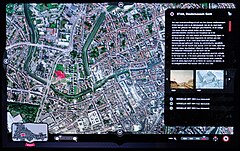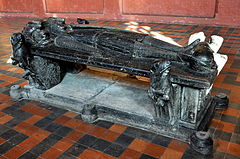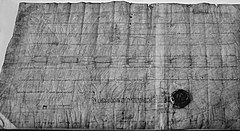Ghent City Museum

STAM | |
 Multimedial introduction to the history of the city of Ghent | |
 | |
| Established | 2010 |
|---|---|
| Location | Ghent, Belgium |
| Coordinates | 51°02′37″N 3°43′01″E / 51.043486°N 3.716970°E |
| Type | Cultural history |
| Website | http://www.stamgent.be |
The Ghent City Museum (in Dutch "Stadsmuseum Gent", "STAM" in short) is a museum in the Belgian city of Ghent. The museum exposes the city history and opened its doors on 9 October 2010.[1] With respect to the collection that is shown, the history of this museum goes back to 1833, the year in which the Oudheidkundig Museum van de Bijloke in Ghent was founded. In 1928 the museum was situated in the Bijloke abbey - this led to the name Bijlokemuseum.
With the Bijloke collection as base and the Bijloke abbey and Bijloke monastery as buildings, the STAM functions as a modern-day heritage forum. Parts from other collections were added to the Bijloke collection. In connection to the historical buildings a new entrance building was constructed, designed by Ghent's city architect Koen Van Nieuwenhuyse.
The main circuit of the Ghent City Museum serves as a museal and multimedial introduction to a visit to the city of Ghent. The past of the town is illustrated, but also today's life and the future are discussed. The temporary STAM collections describe the phenomenon of "urbanity" by means of contemporary issues. STAM refers the visitor to the city itself and to Ghent's cultural heritage. Chronologically structured rooms invite the visitors to explore various thematics. There is also a section dedicated to the Ghent Altarpiece.
The Ghent City Museum was the winner of the 2012 Flemish Museum Prize.[2]
Eyecatchers
[edit]Eyecatching parts of the museum are the sky picture of Ghent (300 m2 large) on which the visitors can walk around, and software with which Ghent can be viewed in detail and over the course of four centuries. In the Bijloke abbey that can be accessed through a passerelle in glass, the history of the city is told by means of three hundred objects. Views on Ghent is another multimedial application: a screen shows a city view from the year 1534, floor-plans from 1614 and 1912 and a sky picture from the present. There is also a room for temporary exhibitions.
- Interactive floor-plan
- Projection of Gravensteen images
- One of the rooms
- Tomb of Hugo II, viscount of Ghent from 1227 until 1232, in the abbey dining room
- Charter of Louis the Pious, given to the Sint-Baafs abbey, in which Louis confirms her immunity
Issue of Nazi-looted art
[edit]In 2022, an investigative article in De Standaard pointed out that Belgian museums still held art that had been looted during the Nazi occupation from Jews in Belgium.[3] A painting by Gaspar de Crayer which had been seized from the collector Samuel Hartveld, was purchased by the Bijloke museum. The Bijloke Museum later transferred the painting to the Museum of Fine Arts, Ghent, where it remains today.[4]
References
[edit]- ^ "Gent maakt zich op voor feestelijke opening van Stadsmuseum" (in Dutch). Knack. 5 October 2005. Retrieved 22 October 2014.
- ^ "Gentse STAM wint MuseumPrijs 2012". De Standaard. 22 May 2012. Retrieved 22 October 2014.
- ^ "Ook onze musea bezitten naziroofkunst". De Standaard (in Flemish). Retrieved 2022-12-03.
- ^ "Nazi-looted artwork still hangs in Belgian museums". lootedart.com. Retrieved 2022-12-03.
External links
[edit]




